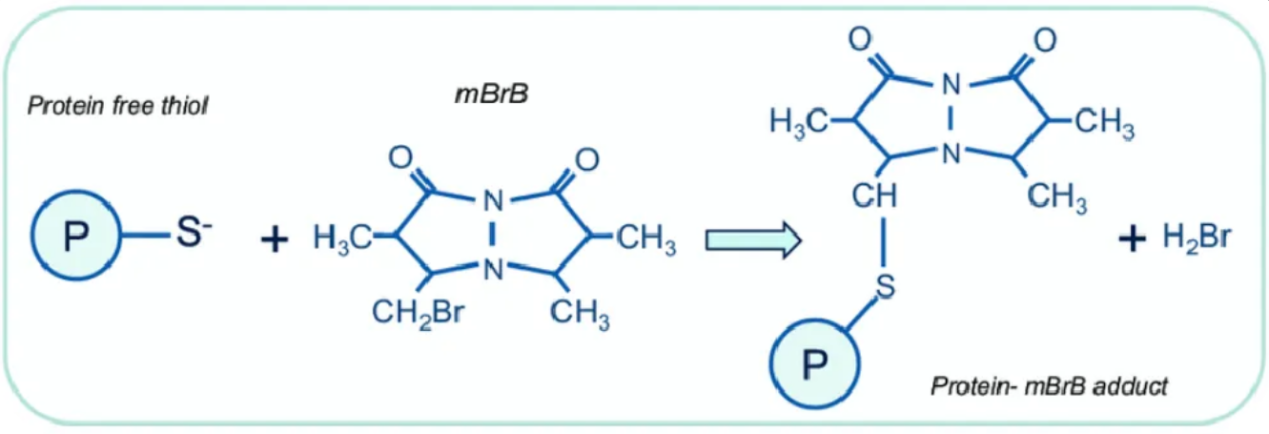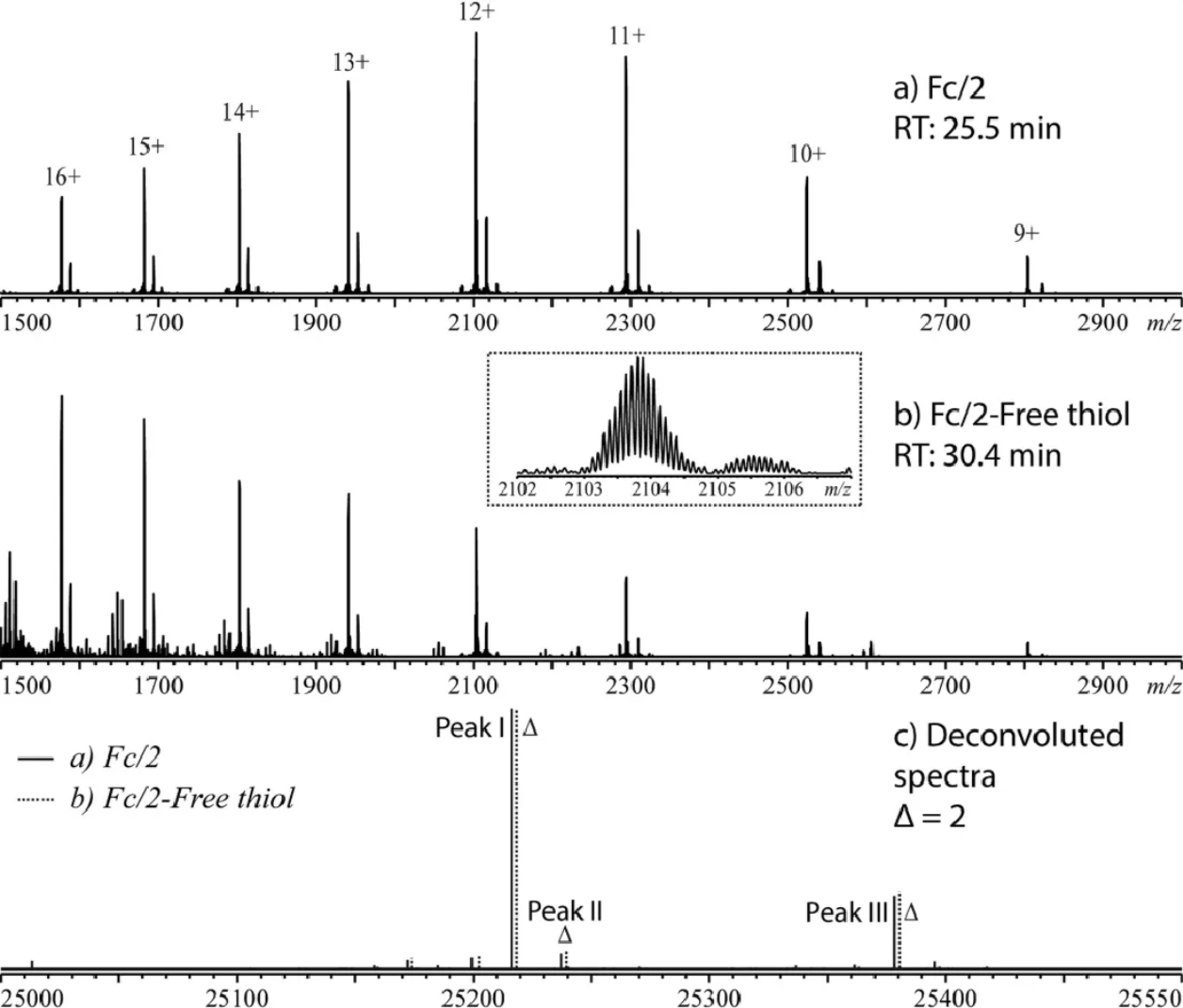Free Thiol Group Analysis Service
Free thiol groups on cysteine residues play essential roles in maintaining protein structure, regulating enzyme activity, and mediating redox signaling. Their reversible reactivity makes them critical regulators of cellular homeostasis under both physiological and pathological conditions.
MtoZ Biolabs provides two specialized Free Thiol Group Analysis Services: targeted analysis of specific proteins and proteome-wide profiling of free thiol groups. These services help researchers study the role of free thiol groups in protein structure, enzyme regulation, and redox signaling.
1. Target Protein Free Thiol Groups Analysis
This service focuses on the precise analysis of free thiol groups on a specific, targeted protein. It is ideal for studying the functional role of thiol groups in individual proteins under various experimental conditions.
2. Free Thiol Groups Proteomics
For a broader analysis, we offer proteome-wide profiling of free thiol groups. This service enables the identification and quantification of free thiol groups across the entire proteome, providing comprehensive insights into redox regulation and thiol biology at the system level.
Depending on the research purpose and sample characteristics, we offer multiple analytical approaches to deliver accurate, reproducible, and biologically meaningful results:
🔸Ellman's Assay (DTNB Method)
A colorimetric approach that reacts free thiol groups with 5,5'-dithiobis-(2-nitrobenzoic acid) (DTNB), producing a yellow-colored product measurable at 412 nm. This method is widely used for rapid, global quantification of thiol content in proteins or complex samples.

Rudyk, O. et al. Redox Biol. 2014.
Figure 1. The Principle of Ellman Assay
🔸Fluorescent Labeling (e.g., Monobromobimane)
Fluorescent reagents such as monobromobimane selectively label free thiols, enabling sensitive detection and quantification. This method offers high specificity and allows analysis of thiol distribution and dynamics under different experimental conditions.

Rudyk, O. et al. Redox Biol. 2014.
Figure 2. Monobromobimane (mBrB) Reacts with the Thiols
🔸LC-MS-Based Analysis
High-resolution mass spectrometry combined with selective labeling provides site-specific identification and quantification of thiol groups in proteins. This approach supports both targeted studies and proteome-wide analysis, delivering comprehensive insights into thiol biology and redox regulation.

Pu, Y. et al. J Chromatogr B Analyt Technol Biomed Life Sci. 2019.
Figure 3. Mass Spectra of (a) Fc/2 Main Peak and (b) One of the Fc/2 Free Thiol Peaks of mAb-A, as well as (c) the Deconvoluted Mass Spectra Overlaid
By tailoring the analytical workflow to project needs, MtoZ Biolabs ensures high data quality, whether for simple thiol content measurement or advanced proteomics-level thiol profiling.
What is Free Thiol Group?
Free thiol groups, primarily found in cysteine side chains, are highly reactive nucleophiles that participate in a wide range of biological processes. They can form disulfide bonds that stabilize protein structure, act as catalytic residues in enzymes, and serve as redox sensors that respond to oxidative changes in the cellular environment. The reactivity of thiols makes them central to redox regulation. They can undergo reversible modifications such as S-nitrosylation, S-glutathionylation, and persulfidation, which function as regulatory switches in signaling pathways. At the same time, irreversible oxidation of thiols to sulfinic or sulfonic acids often reflects oxidative stress and protein damage.
Because of their dual role as functional regulators and sensitive redox markers, free thiols are widely studied in biology and medicine. Dysregulation of thiol homeostasis has been linked to cancer, cardiovascular disease, neurodegeneration, diabetes, and aging. Free thiol group analysis provides valuable insights into redox biology, protein folding, oxidative stress responses, and drug action.
Despite their importance, the inherent reactivity and low abundance of thiol modifications pose analytical challenges. Accurate measurement requires careful sample handling, selective labeling, and sensitive detection methods. MtoZ Biolabs addresses these challenges with optimized workflows that preserve thiol integrity while delivering robust analytical performance.
Analysis Workflow

Sample Submission Suggestions
To achieve optimal results, we recommend:
1. Sample Types
Cells, tissues, plasma, serum, and purified proteins are acceptable. For other types of samples, please contact us in advance for customized guidance.
2. Storage
Flash-freeze samples in liquid nitrogen and store at –80°C.
3. Shipping
Send samples on dry ice to preserve thiol integrity.
4. Replicates
Biological replicates are recommended for robust statistical analysis.
Service Advantages
✔️Cutting-Edge Instrumentation
Utilization of highly sensitive spectrophotometers, fluorescence detectors, and LC-MS/MS platforms ensures precise and consistent analysis of free thiol groups.
✔️Specialized Team Expertise
A group of scientists with deep backgrounds in redox biology and protein chemistry provides dependable data interpretation and technical consultation.
✔️Tailored Workflows
Flexible methodologies adapted to different sample types, labeling strategies, and research objectives deliver project-specific solutions.
✔️Fast Project Delivery
Optimized processes and coordinated project management allow for timely completion without compromising data quality.
Applications
Free thiol group analysis provides insights into diverse research areas:
1. Redox Biology
Understanding thiol-dependent regulation of proteins and signaling pathways.
2. Protein Folding
Monitoring disulfide bond formation and thiol-mediated structural stability.
3. Oxidative Stress Research
Assessing thiol oxidation as a biomarker of oxidative damage.
4. Disease Mechanisms
Linking thiol dysregulation to cancer, cardiovascular disease, diabetes, and neurodegeneration.
5. Drug Development
Evaluating drug effects on thiol states and redox balance.
6. Aging Research
Using thiol content as a marker of cumulative oxidative stress in cells and tissues.
Deliverables
1. Comprehensive Experimental Details
2. Materials, Instruments, and Methods
3. Total Ion Chromatogram & Quality Control Assessment
4. Data Analysis, Preprocessing, and Estimation
5. Bioinformatics Analysis
6. Raw Data Files
By partnering with MtoZ Biolabs, you gain access to comprehensive solutions that not only reveal thiol states with precision but also place them in meaningful biological and clinical contexts, driving your research and development forward with confidence. For more information about our Free Thiol Group Analysis Service, please contact us.







